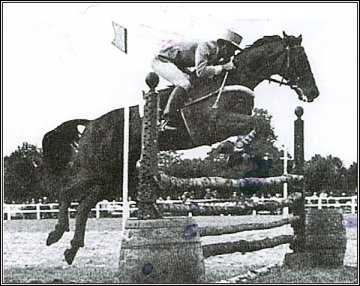|
Jean Luc Cornille
DVD's & CD'S
Wonderful xmas gifts for you or your friends. Give the gift of soundess.
|
|
|
Yes, winning is not everything.
 | | Quolibet and Jean Luc Cornille |
QuolibetZ and Jean Luc Cornille at World Eventing Championship in Punchestown.
In 1971, Rantzeau become ranked 5th best sire of Eventers. Thanks to Quolibet Z and Unic F. (Horse Magazine.com)
Yet, scientific researches are conceived and executed by human been and therefore, investigations and findings are influenced by human nature. For instance, in their etiology of navicular syndrome, Roy Pool, Dennis Maegher and Susan Stover wrote, "Various theories proposing different specific causes for navicular syndrome generally reflect the particular bias or investigative technique of the proponent." (Roy R. Pool, DVM PhD, Dennis M. Maegher, DVM PhD, Susan M. Stover, DVM, PhD, Pathophysiology of Navicular Syndrome. Veterinary Clinics of North America. Equine Practice - Vol5, No 1, April 1989) Both, scientific discoveries and never the less, the practical application of scientific findings, are subjected to our intuitive judgment. If we want to believe that scientific conclusions are accrediting the pyramid of training, we will find a single piece of evidence or two that will satisfy our tuition. Even mental and physical abuses such as hyper-flexion of the upper neck can be supported with scientific data. As well, if we rather believe that the true is in the classic approach, we will find evidences supporting our faith. Then, and instead of beneficiating from the progresses of science, the horse will be submitted to our school of thought. Quolibet Z directed the practical application of equine research studies into a more horse friendly direction. It was the birth of the Science of Motion. After graduating from the Cadre Noir of Saumur, I was affected to a Military Scholl which was combining military and civilian equestrian education. It was a program designed by the French government and aiming at interesting more young riders to the equestrian sports. Quolibet Z was a school horse on the list of being put to sleep for health issues. Military regulations are discharging unhealthy horses or horses unable to assume any useful function. Two discharges are scheduled per year and Quolibet was on the list for the next discharge. He was basically on a death row. He was diagnosed with emphysema, chronic diarrhea and periodic problems with is lymphatic system. Both hind legs were then swelling abundantly. |
Practical Application of the Most Recent Discoveries on the Biomechanics of the Horse's Vertebral Column Equine Books
 This equine book by Jean Luc Cornille is a new encyclopedia. It explains how the horse's vertebral column actually works. Each pertinent finding is explored from the rider and trainer perspective; how such new knowledge does modernize previous perceptions in terms of riding and training techniques.By Jean Luc Cornille This equine book by Jean Luc Cornille is a new encyclopedia. It explains how the horse's vertebral column actually works. Each pertinent finding is explored from the rider and trainer perspective; how such new knowledge does modernize previous perceptions in terms of riding and training techniques.By Jean Luc Cornille
|
|
The Learning Of Forward Movement Jean Luc Cornille
 | | Chazot and Amalia Castro |
In horses, and most other mammalian quadrupeds, 57% of the vertical impulse is applied through the thoracic limbs, and only 43% through the hind limbs. (H. W. Merkens, H. C. Schamhardt,G. J. van Osch, A. J. van den Bogert, 1993).
Chazot is learning here to develop the forelegs propulsive activity at the trot departure. This is done teaching the horse to control accelerations of gravity through his vertebral column and therefore regulating the weight on the forelegs. The riding technique allowing such education is about matching the biomechanical properties of the riders vertebral column with the biomechanical properties of the horses vertebral column. The reins are long and there is no weight on the bit. Once in a while the rider reminds the horse to do not push on the bit.
This technique differs widely from the usual driving the horse onto the bit. Driving the horse onto the bit is a primitive technique that is based on antiquated knowledge of the equine biomechanics. Rushing the horse on the forehand and/or lowering the neck increases the weight on the forelegs. The technique hampers the horses ability to move efficiently and soundly.
|
A word on the creating team
Helyn is the genius behind the images. Jean Luc is the mind behind the words.
Helyn loves horses for who they are, their beauty, their movements. Her professional eye catches postures and expressions that are the touch of class behind each one of our illustrations.
Jean Luc loves horses as great athletes. His respect for them is the force behind his incessant search for better education. Together, they provide the means to add beauty, love for horses, and soundness in the show and the training rings.  | | Jean Luc and Helyn Cornille |
|
|
|